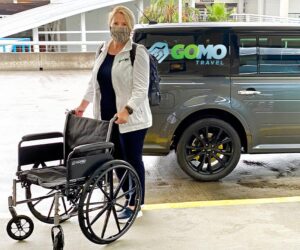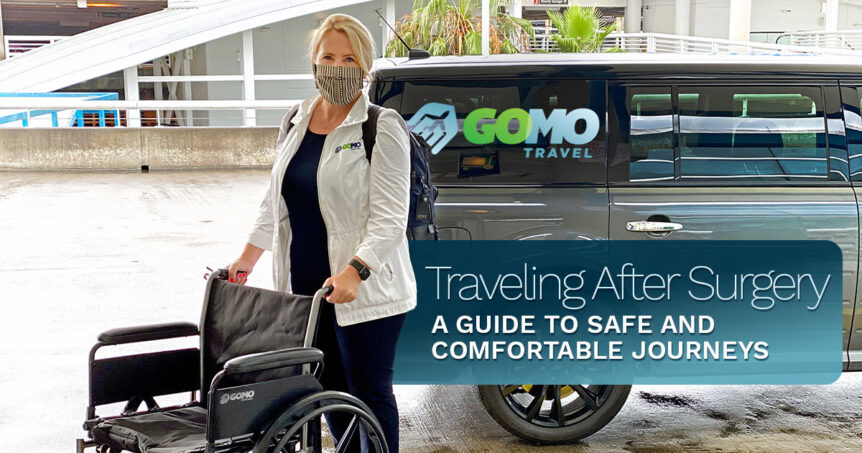For many patients who receive specialized care away from home, traveling after surgery can be a challenging final hurdle. At GOMO Travel, our medically trained travel companions have supported countless patients through this delicate transition, and we’ve gathered our best insights to help you navigate post-surgical travel with confidence and comfort.
Understanding Your Travel Readiness
Not all surgeries are equal, and neither are recovery timelines. Before making any travel arrangements, consult with your medical team about your specific situation. Most healthcare providers will give you a “travel clearance” with guidelines tailored to your condition.
Some important questions to discuss with your surgeon include:
- How soon after surgery can I safely travel?
- What mode of transportation is most appropriate?
- Will I need special accommodations during travel?
- Are there any warning signs I should watch for that would indicate I should delay travel?
Remember that even if you feel ready, your body may still be in a vulnerable state. Rushing your return journey can potentially complicate your recovery or even necessitate a return to medical care.
Planning Your Journey Home
Timing Matters
The timing of your return journey requires careful consideration. In our experience assisting medical travelers, scheduling your trip too soon after surgery can lead to unnecessary complications and discomfort.
For most outpatient procedures, waiting at least 24-48 hours before traveling is advisable. For more invasive surgeries, you might need to remain near the medical facility for several days or even weeks. If possible, build flexibility into your travel plans to accommodate unexpected delays in your recovery timeline.
Choosing the Right Transportation
Your mode of transportation should align with your post-surgical needs. For long-distance travel, several options exist:
Air Travel: The preferred method for post-surgical travel, air travel efficiently covers long distances while minimizing overall travel time and physical strain. For optimal recovery, consider booking direct flights when possible and request special accommodations in advance. Always check with your carrier regarding medical clearance requirements, which are typically straightforward to obtain from your surgeon.
Train Travel: When air travel isn’t available for your route, trains represent a viable alternative in regions where service exists. The ability to move around periodically and the relatively smooth ride can be beneficial during recovery, making trains a reasonable secondary option for mid-range distances.

Automobile Travel: Only advisable when air or train travel isn’t feasible. While car travel does provide flexibility for stops and position adjustments, the extended sitting time, potential for uncomfortable road conditions, and the overall journey duration can significantly hinder recovery. If automobile travel becomes necessary, ensure frequent breaks and bring proper support cushions to minimize discomfort.
For patients with significant mobility limitations or those requiring special medical attention during transport, specialized medical transport services like those provided by GOMO Travel can offer the support and equipment necessary for a safe journey.
Practical Tips for Comfortably Traveling After Surgery
Managing Pain and Medication
Pain management is crucial for comfortable travel. Ensure you have:
- Sufficient prescription medications for the entire journey and several days beyond
- A clear understanding of dosage timing, especially if crossing time zones
- A written list of all medications and dosages in case of emergency
- Non-prescription pain relievers as approved by your doctor
Keep medications in their original containers with clear labels, and always carry them with you rather than packing them in checked luggage.
Preventing Complications
Surgery increases your risk of deep vein thrombosis (DVT), especially during periods of immobility. To minimize this risk:
Make regular movement a priority by walking the aisle of the plane or train when safe to do so or by taking frequent breaks during car travel. Even simple ankle rotations and leg stretches while seated can help maintain circulation.
Stay hydrated by drinking plenty of water throughout your journey, though you may need to balance this with bathroom access, depending on your surgical site and mobility.
Consider compression stockings if recommended by your healthcare provider, as these can significantly reduce the risk of blood clots during travel.
Protecting Your Incision Site
Keeping your surgical site clean and protected is essential during travel:
- Bring extra dressing supplies for changes during long journeys
- Consider wearing loose, comfortable clothing that doesn’t rub against your incision
- Use a small pillow or cushion to protect the area from bumps or pressure
When to Seek Help During Your Journey
Even with careful planning, complications can arise. Know the warning signs that require immediate attention:
- Increased pain, swelling, or drainage at your surgical site
- Fever or chills
- Difficulty breathing
- Significant swelling in your extremities
- Chest pain or unexpected shortness of breath
If you experience any of these symptoms during your journey, don’t hesitate to seek medical assistance. It’s better to pause your travel plans than to risk serious complications.
Consider Professional Assistance
For many patients, especially seniors or those recovering from major procedures, professional travel companionship services can provide invaluable support. At GOMO Travel, our specialized, medically trained travel companions are trained to address the unique needs of post-surgical travelers, from medication management to mobility assistance.
The peace of mind that comes with having a dedicated companion who understands your medical needs can transform a potentially stressful journey into a comfortable transition home.
Remember that your recovery doesn’t end when you leave the hospital. The journey home is an important part of your healing process, and approaching it with proper planning and support can help ensure you arrive safely and comfortably to continue your recovery.
GET STARTED
